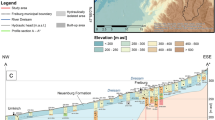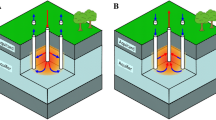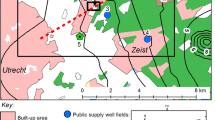Abstract
Aquifer thermal energy storage (ATES) is used for seasonal storage of large quantities of thermal energy. Due to the increasing demand for sustainable energy, the number of ATES systems has increased rapidly, which has raised questions on the effect of ATES systems on their surroundings as well as their thermal performance. Furthermore, the increasing density of systems generates concern regarding thermal interference between the wells of one system and between neighboring systems. An assessment is made of (1) the thermal storage performance, and (2) the heat transport around the wells of an existing ATES system in the Netherlands. Reconstruction of flow rates and injection and extraction temperatures from hourly logs of operational data from 2005 to 2012 show that the average thermal recovery is 82 % for cold storage and 68 % for heat storage. Subsurface heat transport is monitored using distributed temperature sensing. Although the measurements reveal unequal distribution of flow rate over different parts of the well screen and preferential flow due to aquifer heterogeneity, sufficient well spacing has avoided thermal interference. However, oversizing of well spacing may limit the number of systems that can be realized in an area and lower the potential of ATES.
Résumé
Le stockage d’énergie thermique en aquifère (STEA) est utilisé pour le stockage saisonnier de grandes quantités d’énergie thermique. A cause de l’augmentation de la demande pour des énergies durables, le nombre de systèmes STEA a augmenté rapidement, ce qui a fait émerger des questions sur l’effet des systèmes STEA sur leur environnement proche ainsi que sur leur performance thermique. De plus, l’augmentation de la densité des systèmes génère une inquiétude sur les interférences thermiques entre les puits d’un système et entre les systèmes voisins. Une évaluation est faite sur (1) la performance du stockage thermique et (2) le transport de chaleur autour des puits de systèmes STEA existants aux Pays Bas. La reconstitution des débits et des températures d’injection et d’extraction à partir d’enregistrements horaires des données opérationnelles entre 2005 et 2012 montre que le taux de récupération thermique est de 82 % pour le stockage froid et de 68 % pour le stockage chaud. Le transport de chaleur dans le sous-sol est enregistré à partir de capteurs de température distribués. Bien que les mesures révèlent une distribution inégale des débits pour différentes sections des crépines des forages et un écoulement préférentiel dû à l’hétérogénéité de l’aquifère, un espace suffisant entre forages a évité une interférence thermique. Cependant, le surdimensionnement de l’espace entre les forages peut limiter le nombre de systèmes qui peuvent être réalisés dans une région et diminuer le potentiel des STEA.
Resumen
El almacenamiento de energía termal en acuíferos (ATES) se utiliza para el almacenamiento estacional de grandes cantidades de energía termal. Debido a la creciente demanda de energía sustentable, el número de sistemas ATES se ha incrementado rápidamente, lo cual ha planteado cuestiones sobre los efectos de los sistemas ATES en sus alrededores y también acera de su rendimiento termal. Más aún, la creciente densidad de sistemas genera preocupación en la interferencia termal entre los pozos de un sistema y entre los sistemas vecinos. Se realizó una evaluación de: (1) el rendimiento del almacenamiento termal, y (2) el transporte de calor alrededor de los pozos de un sistema ATES existente en Holanda. La reconstrucción de los caudales de flujo y las temperaturas de inyección y extracción a partir de registros horarios de los datos operacionales desde 2005 a 2012 muestran que el promedio de recuperación termal es de 82 % para el almacenamiento frío y de 68 % para almacenamiento de calor. El transporte de calor en el subsuelo es monitoreado usando un sensoramiento distribuido de temperaturas. Aunque las mediciones revelan una distribución desigual de los caudales de flujo sobre diferentes partes del filtro y flujo preferencial debido a la heterogeneidad del acuífero, un espaciado suficiente de pozos ha evitado la interferencia termal. Sin embargo, sobredimensionar el espaciado de los pozos puede limitar el número de sistema que puede ser operativos en un área y disminuir el potencial de ATES.
Resumo
O armazenamento de energia térmica em aquíferos (ATES) é usado para armazenamento sazonal de grandes quantidades de energia térmica. Devido à crescente necessidade de energia sustentável, o número de sistemas ATES tem aumentado rapidamente, o que levantou questões sobre o efeito dos ATES nas suas proximidades, bem como sobre o seu desempenho térmico. Para além do mais, o aumento da densidade dos sistemas gera preocupações sobre a interferência térmica entre os furos de um sistema e entre sistemas vizinhos. É feita uma avaliação: (1) do desempenho do armazenamento térmico, e (2) do transporte de calor em redor dos furos num sistema ATES existente na Holanda. A reconstrução das taxas de fluxo e as temperaturas de injeção e de extração a partir de registos horários dos dados operacionais de 2005 a 2012 mostram que a recuperação térmica média é de 82 % para o armazenamento de frio e de 68 % para o armazenamento de calor. O transporte de calor de subsuperfície é monitorizado através da utilização de sensores de temperatura distribuídos no aquífero. Apesar das medições revelarem uma distribuição desigual das taxas de fluxo em diferentes posições dos ralos nos furos e fluxos preferenciais devidos à heterogeneidade do aquífero, um espaçamento suficiente dos furos tem evitado a interferência térmica. No entanto, o aumento do espaçamento entre furos pode limitar o número de sistemas que podem ser constituídos numa determinada área e baixar o potencial dos ATES.















Similar content being viewed by others
References
Bakr M, van Oostrom N, Sommer WT (2013) Efficiency of and interference among multiple aquifer thermal energy storage systems: a dutch case study. Renewable Energ 59:39–48
Berendsen HJA (1998) De vorming van het land [The formation of the land]. Van Gorcum, Assen, The Netherlands
Bridger DW, Allen DM (2010) Heat transport simulations in a heterogeneous aquifer used for aquifer thermal energy storage (ATES). Can Geotech J 47(1):96–115
Buik NA, Snijders AL (2012) Clogging of recharge wells in porous media. Paper presented at InnoStock 2012, Catalonia, Spain, May 2012
Buik NA, Willemsen A, Verbeek CMJ (2003) Effecten van thermische opslagsystemen: berekeningen en metingen [Effects of thermal storage systems: calculations and measurements]. Stromingen 9(2):33–43
CBS (2010) Hernieuwbare energie in Nederland 2009 [Renewable energy in the Netherlands 2009]. Centraal Bureau voor de Statistiek, Den Haag
Chevalier S, Banton O (1999) Modelling of heat transfer with the random walk method, part 1: application to thermal energy storage in porous aquifers. J Hydrol 222(1–4):129–139
De Mulder EFJ, Geluk MC, Ritsema I, Westerhoff WE, Wong TE (2003) De Ondergrond van Nederland [The subsurface of the Netherlands]. Geologie van Nederland, vol 7. Nederlands Instituut voor Toegepaste Geowetenschappen TNO, Utrecht, The Netherlands, 379 pp
Dickinson JS, Buik N, Matthews MC, Snijders A (2009) Aquifer thermal energy storage: theoretical and operational analysis. Geotechnique 59(3):249–260
Doughty C, Hellstrom G, Tsang CF, Claesson J (1982) A dimensionless parameter approach to the thermal-behavior of an aquifer thermal-energy storage-system. Water Resour Res 18(3):571–587
Drijver B, van Aarssen M, Zwart B (2012) High-temperature aquifer thermal energy storage (HT-ATES): sustainable and multi-usable. Paper presented at InnoStock 2012, Catalonia, Spain, May 2012
Ferguson G (2007) Heterogeneity and thermal modeling of ground water. Ground Water 45(4):485–490
Ferguson G, Woodbury AD (2006) Observed thermal pollution and post-development simulations of low-temperature geothermal systems in Winnipeg, Canada. Hydrogeol J 14(7):1206–1215
Giesen van de N, Steele-Dunne SC, Jansen J, Hoes O, Hausner MB, Tyler S, Selker J (2012) Double-ended calibration of fiber-optic raman spectra distributed temperature sensing data. Sensors 12(5):5471–5485
Glorie FH, den Hartog F (2001) Report of well constructions, De Ruiter Boringen en Bemalingen, Zwanenburg, The Netherlands
Harper ML (1971) Approximate geothermal gradients in the North Sea Basin. Nature 230:235–236
Hausner MB, Suarez F, Glander KE, van de Giesen N, Selker JS, Tyler SW (2011) Calibrating single-ended fiber-optic Raman spectra distributed temperature sensing data. Sensors 11(11):10859–10879
Herbert A, Arthur S, Chillingworth G (2012) Large scale exploitation of ground source energy for heating and cooling: resource constraints and management options in urban aquifers. InnoStock 2012, Catalonia, Spain, May 2012
Kangas MT, Lund PD (1994) Modeling and simulation of aquifer storage energy-systems. Sol Energy 53(3):237–247
Kim J, Lee Y, Yoon WS, Jeon JS, Koo MH, Keehm Y (2010) Numerical modeling of aquifer thermal energy storage system. Energy 35(12):4955–4965
Kipp KL (1987) HST3D: A computer code for simulation of heat and solute transport in three-dimensional ground-water flow systems. US Geological Survey, Denver, CO
Koenders MJB, Zwart de B (2007) Koude/warmteopslag in de praktijk: Meetgegevens van 67 projecten [ATES in practice: measurements on 67 systems]. 2/56280/MaK, IF Technology, Arnhem, The Netherlands
Kowalczyk W, Havinga J (1991) A case study on the influence of the distance between wells on a doublet well aquifer thermal performance. Paper presented at Thermastock 91, Scheveningen, The Netherlands, May 1991
Lee KS (2010) A review on concepts, applications, and models of aquifer thermal energy storage systems. Energies 3(6):1320–1334
Lee KS, Jeong SJ (2008) Numerical modeling on the performance of aquifer thermal energy storage system under cyclic flow regime. Int J Green Energy 5(1–2):1–14
Molz FJ, Parr AD, Andersen PF (1981) Thermal-energy storage in a confined aquifer: 2nd cycle. Water Resour Res 17(3):641–645
Molz FJ, Melville JG, Parr AD, King DA, Hopf MT (1983) Aquifer thermal-energy storage: a well doublet experiment at increased temperatures. Water Resour Res 19(1):149–160
NVOE (2006) Werkwijzen en richtlijnen ondergrondse energieopslag [Methods and guidelines underground energy storage]. NVOE, MarktMonitor, Woerden, The Netherlands
Sanner B, Karytsas C, Mendrinos D, Rybach L (2003) Current status of ground source heat pumps and underground thermal energy storage in Europe. Geothermics 32(4–6):579–588
Sauty JP, Gringarten AC, Menjoz A, Landel PA (1982a) Sensible energy-storage in aquifers: 1, theoretical-study. Water Resour Res 18(2):245–252
Sauty JP, Gringarten AC, Fabris H, Thiery D, Menjoz A, Landel PA (1982b) Sensible energy-storage in aquifers: 2, field experiments and comparison with theoretical results. Water Resour Res 18(2):253–265
Selker JS, Thevenaz L, Huwald H, Mallet A, Luxemburg W, Giesen NV van de, Stejskal M, Zeman J, Westhoff M, Parlange MB (2006) Distributed fiber-optic temperature sensing for hydrologic systems. Water Resour Res 42 (12):W12202
Sensornet www.sensornet.co.uk. Accessed December 2012
SIKB (2010) version 1.0, date of issue: 17 June 2010. Stichting Infrastructuur Kwaliteitsborging Bodembeheer (SIKB), Gouda, The Netherlands. www.sikb.nl. Accessed December 2012
Staatscourant (2011) Wijzigingsbesluit bodemenergiesystemen [Amendment subsurface energy systems]. Staatscourant 2011 no. 4830, p 29. https://zoek.officielebekendmakingen.nl/stcrt-2011-4830.html. Accessed October 2013
Starink L, Hehenkamp M (2001) Koude-/warmteopslag Noordwesthoek Uithof Utrecht: Effectenstudie grondwatersysteem (ATES in the northwest corner of Uithof Utrecht: study on the effect on the groundwater system) 2/50168/LS. IF Technology, Arnhem, The Netherlands
van Dalfsen W (1981) Geothermal investigation in shallow observation wells: the shallow subsurface temperature field in the Netherlands. TNO, Utrecht, The Netherlands
Vernes RW, van Doorn THM (2005) Van gidslaag naar hydrogeologische eenheid, toelichting op de totstandkoming van de dataset REGIS II [From Marker Layer to Hydrogeological Unit, Explanatory Notes to the making of the REGIS II dataset]. TNO report NITG 05-038-B, TNO, Utrecht, The Netherlands
Vogt T, Schneider P, Hahn-Woernle L, Cirpka OA (2010) Estimation of seepage rates in a losing stream by means of fiber-optic high-resolution vertical temperature profiling, J Hydrol 380 (2010) 154–164
Ward JD, Simmons CT, Dillon PJ (2007) A theoretical analysis of mixed convection in aquifer storage and recovery: how important are density effects? J Hydrol 169–186
Weerts HJT, Cleveringa P, Ebbing JHJ, De Lang FD, Westerhoff WE (2000) De lithostratigrafische indeling van Nederland: formaties uit het Tertiair en Kwartair [The lithostratigraphic classification of the Netherlands].TNO, Utrecht, The Netherlands, 38 pp
Zuurbier KG, Hartog N, Valstar J, Post VE, van Breukelen BM (2013) The impact of low-temperature seasonal aquifer thermal energy storage (SATES) systems on chlorinated solvent contaminated groundwater: modeling of spreading and degradation. J Contam Hydrol 147(April 2013:1–13
Acknowledgements
The authors thank Deltares for installing the glass fiber temperature monitoring system, IF Technology for sharing operational data from the BMS, and Utrecht University for allowing access to their ATES system for investigations within this study.
Author information
Authors and Affiliations
Corresponding author
Additional information
Published in the theme issue “Hydrogeology of Shallow Thermal Systems”
Electronic supplementary material
Below is the link to the electronic supplementary material.
ESM 1
(PDF 182 kb)
Rights and permissions
About this article
Cite this article
Sommer, W.T., Doornenbal, P.J., Drijver, B.C. et al. Thermal performance and heat transport in aquifer thermal energy storage. Hydrogeol J 22, 263–279 (2014). https://doi.org/10.1007/s10040-013-1066-0
Received:
Accepted:
Published:
Issue Date:
DOI: https://doi.org/10.1007/s10040-013-1066-0




